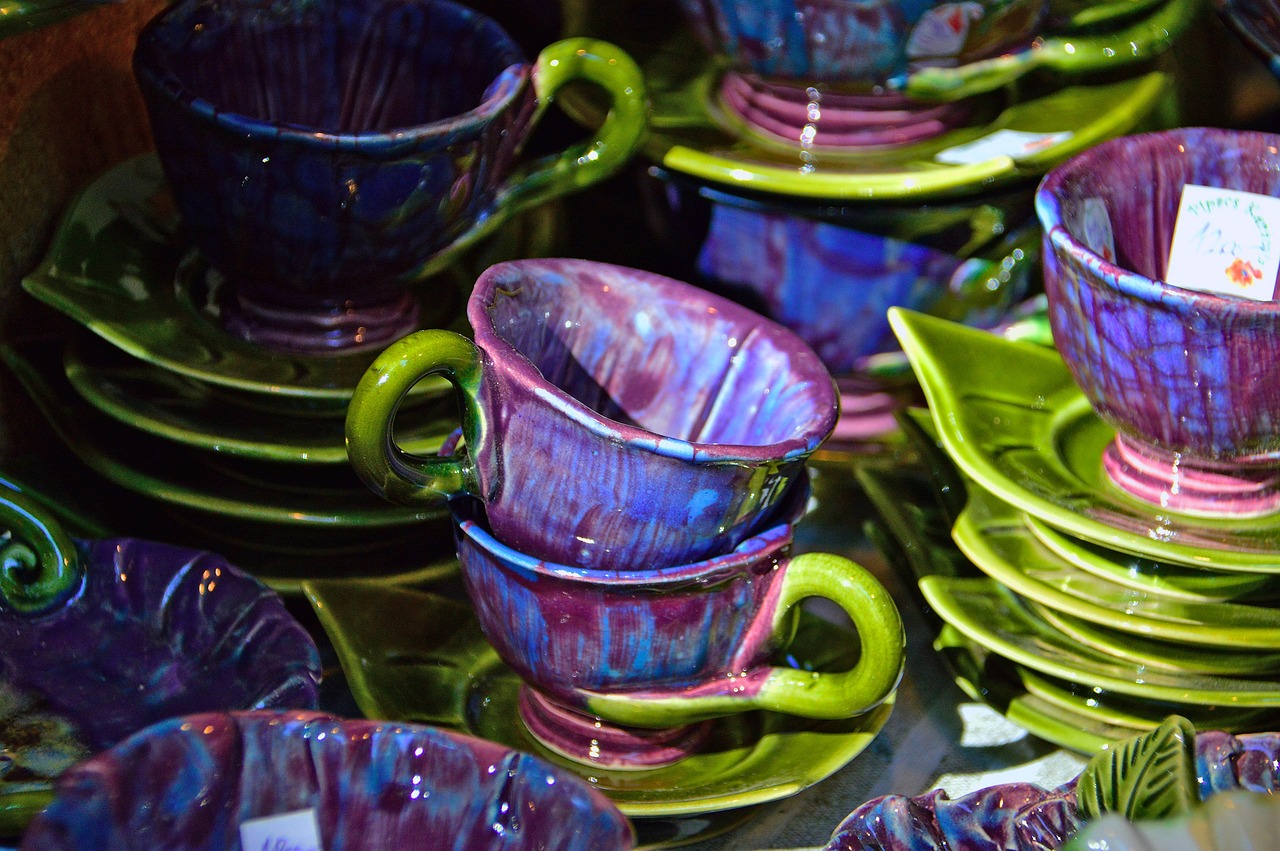How to Turn Your Ceramics Hobby into a Profession
Have you ever found yourself lost in the mesmerizing world of ceramics, molding clay with your hands while your mind drifts into a realm of creativity? If you're nodding your head, then you're in the right place! Transforming your ceramics hobby into a profession is not just a dream; it's a journey filled with excitement, challenges, and endless possibilities. Imagine waking up every day, excited to create beautiful pieces that not only reflect your artistic vision but also bring joy to others. This article will guide you through the practical steps to make that dream a reality, covering everything from identifying your niche to marketing your creations effectively.
First things first, let’s talk about the importance of finding your niche. In the vast world of ceramics, standing out is essential. Are you drawn to functional pieces like mugs and bowls, or do you prefer sculptural art? Understanding your unique style and target audience will set the foundation for your business. The journey begins with self-discovery—take time to explore various techniques and styles. Ask yourself questions like: What inspires me? Who would appreciate my work? This exploration not only nurtures your creativity but also helps you resonate with potential customers.
Next up is building your skills. Mastering the technical aspects of ceramics is crucial for professional success. This means diving deep into essential techniques, materials, and resources that can enhance your craftsmanship. From hand-building to wheel-throwing, each method offers unique challenges and opportunities for artistic expression. Have you ever tried hand-building? It’s like sculpting with your soul—allowing for creative freedom and personalization in your pieces. On the other hand, wheel-throwing requires practice and patience, almost like learning to dance with the clay. Both methods can significantly shape your artistic journey and help you develop a style that is distinctly yours.
Don’t forget about glazing and finishing. This is where your pieces come to life! The right glaze can transform a simple bowl into a stunning centerpiece. Understanding different glazing techniques and experimenting with various types of glazes will not only enhance the visual appeal of your work but also increase its value. Think of glazing as the final touch on a masterpiece—it's what makes your creations truly shine!
Once you've honed your skills, it’s time to create a business plan. This is the roadmap that will guide you as you turn your passion into a profession. A solid business plan should include market research to understand your target audience and financial projections to ensure sustainability. Conducting effective market research is like being a detective—you need to uncover customer preferences and trends in the ceramics industry. This information will help you tailor your offerings and make informed decisions.
Financial planning is another critical component. Budgeting, pricing your work, and managing expenses may sound daunting, but with the right strategies, you can navigate this aspect with confidence. Think of it as laying a strong foundation for your business—without it, everything else could crumble.
Now, let’s dive into marketing your creations. In today’s digital age, effective marketing strategies are vital for reaching potential customers. Social media platforms like Instagram and Facebook can be powerful tools for showcasing your work and connecting with your audience. Have you ever scrolled through beautifully curated feeds of ceramic artists? That could be you! Share behind-the-scenes processes, engage with your followers, and build a community around your art.
Participating in craft fairs is another fantastic way to promote your ceramics. These events not only allow you to sell your work but also offer a chance to network with fellow artists and potential customers. Picture yourself at a vibrant market, surrounded by like-minded creators, sharing stories, and exchanging ideas. It’s a great way to gain exposure and receive valuable feedback on your work.
Lastly, establishing an online presence is crucial for modern artisans. A professional website can showcase your portfolio and allow customers to purchase your work directly. Think of your website as your virtual storefront—make it inviting and easy to navigate. Additionally, choosing the right e-commerce platform can significantly enhance your sales efforts. Platforms like Etsy and Shopify are popular among artists, but don’t overlook the potential of a personal website tailored to your brand.
- How long does it take to turn my hobby into a profession? The timeline varies depending on your dedication, skill level, and market demand, but with consistent effort, you can see progress within a year.
- Do I need formal training in ceramics? While formal training can be beneficial, many successful ceramic artists are self-taught. Passion and practice are key!
- What are the best platforms to sell my ceramics online? Popular options include Etsy, Shopify, and your own website. Choose one that aligns with your brand and goals.

Identifying Your Niche
When it comes to transforming your ceramics hobby into a profession, one of the most important steps is . This is not just about making beautiful pottery; it’s about finding a specific area within the ceramics world that resonates with your unique style and speaks to a particular audience. Think of it as finding your own corner in a vast art gallery—your niche is the space where your creativity can shine the brightest.
To start the journey of discovering your niche, you might want to consider the following aspects:
- Your Artistic Style: What kind of ceramics do you enjoy creating? Are you drawn to functional pieces like mugs and bowls, or do you prefer sculptural works? Understanding your personal style will help you define your niche.
- Target Audience: Who do you envision using or appreciating your work? Identifying your target audience can guide your design choices and marketing strategies.
- Market Trends: Keep an eye on current trends within the ceramics community. What styles are popular? Are there gaps in the market that you could fill with your unique creations?
Once you’ve reflected on these aspects, it might be helpful to conduct a little bit of research. Look at what other ceramicists are doing and see where you can carve out your own space. Perhaps you could focus on eco-friendly materials, or maybe you could specialize in a specific technique like Raku firing or majolica glazing. The key is to find a balance between what you love to create and what potential customers are looking for.
Don't be afraid to experiment! Sometimes, your niche may not be immediately obvious. It could take some trial and error to discover what truly resonates with you and your audience. Try out different styles, techniques, and themes in your work. This exploration can often lead to unexpected and delightful results, which can further refine your niche.
In the end, remember that your niche is not just a label; it’s an extension of who you are as an artist. It’s what will set you apart in a crowded market and make your creations memorable. So take the time to explore, experiment, and ultimately embrace your unique artistic voice.

Building Your Skills
When it comes to transforming your ceramics hobby into a profession, mastering your craft is absolutely essential. You might be wondering, "What does it take to become a skilled ceramic artist?" Well, it's all about practice, exploration, and a bit of guidance along the way. To truly excel, you need to dive deep into the technical aspects of ceramics, from understanding the materials you work with to honing the various techniques that will set your work apart. Think of it like learning to ride a bike; at first, you might wobble and fall, but with time and persistence, you’ll be zooming down the street with confidence.
One of the first steps in building your skills is to explore the different techniques available in ceramics. Each method offers unique possibilities and challenges that can shape your artistic journey. For instance, you might find yourself drawn to hand-building techniques, where you can let your creativity flow freely. Alternatively, you may prefer the precision and control of wheel-throwing. Each approach has its own learning curve, but both can lead to stunning results.
Let’s break it down a bit more. Here are some of the key techniques you might want to explore:
- Hand-Building: This technique allows for a lot of creative freedom. You can mold and shape your pieces without the constraints of a wheel. It's perfect for creating unique, one-of-a-kind items.
- Wheel-Throwing: If you crave precision, wheel-throwing might be your go-to. It requires practice to master, but the results can be incredibly rewarding.
- Glazing: This is where the magic happens! Glazing adds color and texture to your pieces, giving them that final touch that makes them stand out.
Hand-building techniques are fantastic for those who enjoy a more tactile approach to ceramics. Methods like pinch pots, coil building, and slab construction allow you to create forms that reflect your personal style. Pinch pots, for example, are made by simply pinching the clay into shape, while coil building involves rolling out long strands of clay and stacking them to create larger forms. Slab construction, on the other hand, allows you to create flat pieces that can be assembled into more complex structures. The beauty of hand-building is that it encourages experimentation; don’t be afraid to try new things!
Now, if you’re leaning towards wheel-throwing, be prepared for a bit of a learning curve. This technique requires you to center the clay on the wheel, which can be tricky at first. However, once you get the hang of it, you'll be able to shape bowls, mugs, and vases with ease. It’s like learning to dance; it takes time to find your rhythm, but once you do, you’ll be amazed at what you can create!
Finally, let’s talk about glazing and finishing. This step is crucial because it adds color and personality to your creations. There are various types of glazes you can experiment with, each offering different effects. Some glazes are glossy, while others are matte; some can even create stunning textures. The key is to understand how different glazes interact with each other and with the clay body. Practice makes perfect here, so don’t hesitate to test out different combinations until you find your signature style.
In conclusion, building your skills in ceramics is a journey filled with exploration and discovery. Whether you choose hand-building, wheel-throwing, or glazing, the important thing is to keep practicing and pushing your creative boundaries. Remember, every great artist started somewhere, and with dedication and passion, you can turn your ceramics hobby into a thriving profession!
Q: How long does it take to become skilled in ceramics?
A: The time it takes to become skilled varies depending on the individual and the techniques they choose to focus on. With regular practice, you can start seeing significant improvement in a matter of months.
Q: Do I need formal training to succeed in ceramics?
A: While formal training can be beneficial, many successful ceramic artists are self-taught. The key is to practice consistently and seek out resources, whether online or through workshops.
Q: What materials do I need to start working with ceramics?
A: Basic materials include clay, tools for shaping, a pottery wheel (if you’re wheel-throwing), and glazes. As you progress, you can expand your toolkit to include more specialized items.

Understanding Different Techniques
When it comes to ceramics, the journey of creativity is as rich and varied as the clay itself. Each technique offers a unique way to express your artistic vision, and understanding these methods can significantly enhance your craftsmanship. Whether you're a newbie or someone with a bit of experience, diving into the different techniques can feel like opening a treasure chest of possibilities. So, let’s explore some of the most popular ceramic techniques that can help you shape your artistic journey.
One of the most fundamental techniques in ceramics is hand-building. This method is all about using your hands to create forms without the aid of a pottery wheel. It’s like sculpting with clay, allowing for incredible freedom and personalization. You can create anything from simple pinch pots to intricate sculptures. The beauty of hand-building lies in its accessibility; you don’t need expensive equipment to get started. Just your hands, some clay, and a creative spark!
In contrast, wheel-throwing is a technique that requires practice and patience, much like learning to ride a bike. Once you get the hang of it, though, the results can be incredibly rewarding. Wheel-throwing involves using a potter’s wheel to shape the clay into symmetrical forms. The process requires you to center the clay and apply pressure in just the right way. It can be challenging at first, but with consistent practice, you’ll find yourself throwing beautiful bowls, vases, and more.
Finally, let’s not forget about glazing. This is where the magic really happens! Glazing adds color, texture, and a protective layer to your ceramic pieces. There are various types of glazes, each offering different finishes, from glossy to matte, and even textured effects. Understanding how to apply glazes effectively can elevate your work from simple pottery to stunning art pieces. It’s essential to experiment with different glazes and firing techniques to discover what works best for your style.
| Technique | Description | Key Features |
|---|---|---|
| Hand-Building | Creating forms using hands without a wheel. | Creative freedom, personalized designs |
| Wheel-Throwing | Shaping clay on a potter’s wheel. | Symmetrical forms, requires practice |
| Glazing | Applying a glass-like coating to ceramics. | Adds color, texture, and protection |
In summary, understanding these different techniques is not just about mastering them; it's about discovering your unique artistic voice. Each method offers a distinct way to manipulate clay and express your creativity. So, whether you find joy in the tactile experience of hand-building, the meditative rhythm of wheel-throwing, or the vibrant world of glazing, embrace the journey. After all, every piece you create is a step towards turning your ceramics hobby into a fulfilling profession!
- What is the easiest technique for beginners? Hand-building is often recommended for beginners due to its simplicity and accessibility.
- How long does it take to learn wheel-throwing? Mastering wheel-throwing can take time; many people practice for several months before feeling confident.
- Can I mix different glazing techniques? Yes! Experimenting with different glazing techniques can lead to unique and beautiful results.

Hand-Building Techniques
Hand-building is one of the most creative and versatile approaches to ceramics, allowing artists to mold and shape their pieces without the use of a potter's wheel. This technique opens up a world of possibilities, enabling you to create unique forms and intricate designs that truly reflect your artistic vision. Whether you’re a beginner or a seasoned pro, mastering hand-building techniques can elevate your ceramics game to new heights.
There are several fundamental methods in hand-building that every aspiring ceramicist should explore. These techniques not only enhance your skills but also allow you to express your individuality through your work. Let's dive into some of the most popular hand-building methods:
- Pinch Pots: This is a great starting point for beginners. By simply pinching the clay between your fingers, you can create small bowls or decorative pieces. The beauty of pinch pots lies in their organic shapes, which can be further embellished with textures or glazes.
- Coil Building: This technique involves rolling out long, snake-like pieces of clay and stacking them to form walls. Coil building is perfect for creating larger objects such as vases or sculptures. The process allows for great flexibility, as you can easily modify the shape as you go along.
- Slab Construction: Slab building involves rolling out flat pieces of clay that can be cut and assembled to create various forms. This method is ideal for making boxes, tiles, or even intricate wall art. The key here is to ensure that the slabs are of even thickness to avoid cracking during the firing process.
Each of these techniques offers its own set of challenges and rewards. For instance, while pinch pots are quick and easy to make, they can also be prone to cracking if the clay is too dry. On the other hand, coil building allows for greater control over the form but requires more time and patience. Slab construction can yield stunning results, but it demands precision in cutting and joining the pieces.
As you experiment with these hand-building techniques, don’t hesitate to combine them! Mixing methods can lead to truly innovative and unexpected outcomes. For example, you might start with a pinch pot base and then add coil details or slab elements to enhance the design. The possibilities are endless, and that’s what makes hand-building so exciting.
Moreover, don't forget the importance of texture and surface decoration. You can use various tools and materials, such as stamps, brushes, or even natural objects like leaves, to add unique patterns and designs to your pieces. This not only enhances the visual appeal but also adds a personal touch that sets your work apart from others.
In conclusion, hand-building techniques are a fantastic way to unleash your creativity in ceramics. By mastering these methods, you’ll not only improve your craftsmanship but also develop a distinctive style that resonates with your audience. So grab some clay, roll up your sleeves, and start creating your masterpiece!
- What is the best clay for hand-building?
The best clay for hand-building depends on your project. Earthenware is great for beginners due to its workability, while stoneware offers durability for functional pieces.
- Can I use air-dry clay for hand-building?
Yes! Air-dry clay is a convenient option for those who do not have access to a kiln. However, it may not be as strong or durable as fired clay.
- How do I prevent my clay from drying out while working?
Keep your clay covered with a damp cloth or plastic wrap when you're not using it. This helps maintain moisture and prevents cracking.

Wheel-Throwing Basics
Wheel-throwing is one of the most captivating techniques in ceramics, allowing artists to create beautifully symmetrical forms with a spinning potter’s wheel. If you're just starting out, it might feel a bit like trying to ride a bike for the first time—challenging at first, but incredibly rewarding once you find your balance. The key to mastering wheel-throwing lies in understanding a few fundamental principles, which we'll explore below.
First and foremost, centering the clay is crucial. This is the process of getting your clay lump perfectly balanced on the wheel. Imagine trying to spin a top that’s off-center; it wobbles and falls. Similarly, if your clay isn't centered, the forms you create will be uneven and frustrating. To center the clay, you’ll need to apply consistent pressure with your hands while the wheel spins, gradually shaping the clay into a smooth mound. It takes practice, but once you get the hang of it, it feels like a dance!
Once your clay is centered, the next step is shaping your piece. This is where creativity comes into play. You can create a variety of forms, from bowls to vases, simply by manipulating the clay with your hands and tools as the wheel spins. A good tip is to keep your hands wet to prevent the clay from sticking and to maintain a smooth surface. As you shape, remember to apply gentle pressure; too much force can cause the clay to collapse. Think of it as coaxing the clay into the desired shape rather than forcing it.
After shaping, the next phase is trimming. This involves refining your piece after it has been thrown and has started to set up a bit. Trimming allows you to add details and remove excess clay, giving your work a professional finish. You can use a trimming tool to carve away the excess while the piece is still on the wheel. This is also a great opportunity to create a foot for your pot, which adds stability and elegance.
Finally, let’s not forget about the importance of practice. Just like any other skill, the more you practice wheel-throwing, the better you will become. It’s not uncommon for beginners to feel disheartened after a few failed attempts, but remember that every artist has gone through the same learning curve. Embrace the mistakes as part of your journey. Each wobble and uneven edge is a lesson that brings you closer to mastering the wheel.
To summarize, here are the basic steps to get started with wheel-throwing:
- Center the clay on the wheel.
- Shape your piece using gentle pressure.
- Trim and refine your work as it sets.
- Practice consistently to improve your skills.
As you embark on your wheel-throwing journey, remember that patience and perseverance are your best friends. With time, you’ll find yourself creating stunning pieces that reflect your unique style and creativity. So, roll up your sleeves, get your hands muddy, and let the wheel take you on a wonderful artistic adventure!

Glazing and Finishing
When it comes to ceramics, the magic often happens in the final stages—specifically, during the glazing and finishing processes. Glazing is not just about adding color; it’s about transforming your piece into something that can withstand the test of time while also being visually stunning. Imagine your piece as a blank canvas; the glaze is the paint that brings it to life, adding depth, shine, and texture. But how do you achieve that perfect finish? Let’s dive into the world of glazes and finishing techniques!
First and foremost, understanding the different types of glazes is essential. There are two primary categories: glossy and matte. Glossy glazes provide a shiny, reflective surface that enhances colors and patterns, making them pop. On the other hand, matte glazes offer a more subdued, earthy feel, which can be perfect for rustic or minimalist designs. Each type has its unique application methods and effects, so experimenting with both can help you discover what works best for your style.
Another important aspect to consider is the application technique. Here are a few popular methods:
- Dipping: This method involves submerging your piece into a bucket of glaze, ensuring an even coating. It’s quick and effective, but requires careful control to avoid drips.
- Brushing: For more intricate designs, brushing on glaze allows for detailed application, but it may require multiple layers to achieve the desired opacity.
- Spraying: This technique provides a smooth, even coat and is excellent for larger pieces, but it requires special equipment and a well-ventilated space.
After applying the glaze, the finishing touches are crucial. This includes techniques like firing, which is where the magic truly happens. Firing your glazed piece in a kiln not only sets the glaze but also enhances its durability. The firing temperature can vary depending on the type of clay and glaze used, so it’s essential to follow the guidelines for your specific materials.
Once your piece is fired, you may want to consider additional finishing techniques. For example, you can use wax resist to create intricate patterns by applying wax to areas you want to remain unglazed. After glazing and firing, removing the wax reveals the original clay color beneath, creating a stunning contrast.
Finally, don’t forget about the importance of safety when working with glazes. Always wear gloves and a mask to protect yourself from dust and fumes, and make sure to work in a well-ventilated area. Proper safety precautions ensure that your creative process remains enjoyable and safe.
In summary, glazing and finishing are not just the final steps in your ceramics journey; they are opportunities to express your artistic vision. By understanding the types of glazes, mastering application techniques, and implementing effective finishing methods, you can elevate your ceramics from simple objects to works of art that captivate and inspire.
Q: What is the difference between earthenware, stoneware, and porcelain glazes?
A: The primary difference lies in the firing temperature and the composition of the clay. Earthenware glazes are typically lower-fired and can be more porous, while stoneware and porcelain glazes are higher-fired, resulting in a more durable and less porous finish.
Q: Can I mix different glazes together?
A: Yes, mixing glazes can create unique effects and colors. However, it's essential to test your mixtures on small samples before applying them to larger pieces, as the results can be unpredictable.
Q: How do I know if my glaze is food safe?
A: Always check the manufacturer's specifications. Food-safe glazes are specifically formulated to be non-toxic and durable for use with food items.

Creating a Business Plan
Transforming your ceramics hobby into a thriving business requires more than just passion and creativity; it necessitates a well-thought-out business plan. Think of your business plan as a roadmap that guides you through the intricate landscape of entrepreneurship. It’s not just a document; it’s your vision in action, helping you navigate challenges and seize opportunities. So, what should you include in this essential blueprint?
First and foremost, market research is your starting point. Understanding your target audience is crucial. Who are they? What do they want? You need to dive deep into the world of ceramics enthusiasts, collectors, and casual buyers. This research will help you tailor your offerings and marketing strategies to meet their needs. You might want to consider factors like:
- Demographics: Age, income level, and location of your potential customers.
- Preferences: What styles or types of ceramics are trending?
- Competition: Who else is in the market, and what are they offering?
Once you have a grasp on your market, it’s time to tackle the financial planning aspect. This part of your business plan will help ensure that your ceramics venture is sustainable in the long run. Start by outlining your expected costs, which can include materials, studio space, marketing, and other operational expenses. Then, think about how you’ll price your work. Will you adopt a cost-plus pricing model, or will you consider the perceived value of your art? Here’s a simple breakdown of what to include in your financial plan:
| Expense Type | Estimated Cost |
|---|---|
| Materials | $500/month |
| Studio Rent | $1,200/month |
| Marketing | $300/month |
| Miscellaneous | $200/month |
Next, set clear financial projections for the next three to five years. This includes estimating your sales, understanding your break-even point, and projecting your profit margins. It’s like plotting a course for a road trip; you need to know when to stop for gas and how long it’ll take to reach your destination.
Finally, don’t forget to incorporate your marketing strategies into your business plan. How will you attract customers? Will you leverage social media, attend craft fairs, or collaborate with local businesses? A well-rounded marketing strategy is essential for getting your ceramics into the hands of customers. Consider the following:
- Branding: What message do you want to convey through your art?
- Promotional Activities: Will you offer discounts, host workshops, or create a referral program?
- Online Presence: How will you use your website and social media to engage with your audience?
In summary, a solid business plan is your ticket to turning your ceramics passion into a profession. It helps you understand your market, manage your finances, and create effective marketing strategies. Remember, this is a living document that you can adjust as you grow and learn in your ceramics journey. So, roll up your sleeves, get creative, and let your business plan be the wind beneath your wings!
Q: How long should my business plan be?
A: Ideally, your business plan should be concise yet comprehensive. Aim for 15-20 pages, covering all essential aspects without overwhelming details.
Q: Do I really need a business plan?
A: Yes! A business plan helps clarify your goals, strategies, and financial forecasts, making it easier to secure funding and stay focused.
Q: Can I revise my business plan later?
A: Absolutely! Your business plan should evolve as your business grows and market conditions change.

Market Research Essentials
When it comes to turning your ceramics hobby into a thriving business, understanding your target market is not just important; it’s essential. Think of market research as the compass that guides you through the vast ocean of opportunities. Without it, you might find yourself adrift, unsure of where to steer your ship. So, how do you navigate these waters? Let’s break it down.
First off, you need to identify who your potential customers are. Are they art enthusiasts, home decorators, or perhaps people looking for unique gifts? Knowing your audience is like having a secret map that reveals their preferences and buying habits. You can gather this information through surveys, social media interactions, and even casual conversations with friends and family. Ask yourself: What do they like? What are their pain points? This insight will help you tailor your creations to meet their needs.
Next, keeping an eye on industry trends is crucial. The ceramics market, like any other, is influenced by seasonal changes, emerging styles, and consumer behaviors. For example, if you notice a rising trend in sustainable living, you might want to explore eco-friendly materials for your ceramics. You can utilize tools such as Google Trends or social media analytics to observe what’s gaining traction. Here’s a quick overview of some key trends to consider:
| Trend | Description |
|---|---|
| Eco-Friendly Ceramics | Utilizing sustainable materials and practices in production. |
| Personalization | Offering customized pieces that resonate with individual customers. |
| Minimalism | Creating simple, functional designs that appeal to modern aesthetics. |
Furthermore, analyzing your competitors can provide invaluable insights. Look at what others in your niche are doing well and where they might be falling short. This doesn’t mean you should copy them; rather, use this information to carve out your unique space in the market. Ask yourself: What can you offer that they don’t? What’s your unique selling proposition? This self-reflection can lead to innovative ideas that differentiate your work.
Lastly, don’t underestimate the power of networking. Engaging with fellow artists and potential customers through workshops, local events, or online forums can open doors to collaboration and feedback. It’s like building a community around your craft, where you can share experiences and learn from one another. Plus, word-of-mouth recommendations can be a game-changer in attracting new clients.
In summary, effective market research is about understanding your audience, staying ahead of trends, analyzing competitors, and networking within the community. By investing time and effort into these areas, you’ll be well on your way to not just selling ceramics but creating a brand that resonates with your customers.
- What is market research and why is it important?
Market research involves gathering information about your target audience and industry trends. It's important because it helps you understand customer needs and make informed business decisions. - How can I conduct market research?
You can conduct market research through surveys, social media analytics, competitor analysis, and networking with other artists. - What tools can I use for market research?
Tools like Google Trends, social media platforms, and analytics software can provide valuable insights into market trends and customer preferences.

Financial Planning
When it comes to turning your ceramics hobby into a thriving profession, plays a pivotal role. Think of it as the backbone of your business; without it, you might find yourself struggling to stay afloat in the vast sea of entrepreneurship. The first step in effective financial planning is to create a detailed budget that outlines all your expected expenses and income. This budget should include costs such as materials, tools, studio space, and marketing efforts. Additionally, don’t forget to account for unexpected expenses that may arise—like a kiln breakdown or a sudden increase in material prices!
Next, pricing your work appropriately is crucial. Many new artists make the mistake of undervaluing their creations, which can lead to financial strain. To set your prices, consider the following factors:
- Cost of materials
- Time spent creating each piece
- Overhead costs (like utilities and studio rent)
- Market rates for similar items
Once you have a clear understanding of these elements, you can establish a pricing strategy that reflects the value of your work while remaining competitive. Remember, pricing is not just about covering costs; it's also about ensuring you are compensated for your skill and creativity.
Moreover, managing your expenses effectively can make a significant difference in your overall profitability. Keep track of all your financial transactions, and consider using accounting software to simplify this process. Regularly reviewing your financial statements will help you identify trends, allowing you to adjust your strategies as needed. For instance, if you notice that certain materials are eating into your profits, it might be time to explore alternative suppliers or materials.
Lastly, don't overlook the importance of setting financial goals. Whether it’s aiming to save a specific amount for a new kiln or planning to expand your product line, having clear objectives will keep you motivated and focused. You can create a simple table to track your goals and progress:
| Financial Goal | Target Amount | Deadline | Status |
|---|---|---|---|
| New Kiln | $2,000 | 12 months | In Progress |
| Marketing Budget | $500 | 6 months | Pending |
| Craft Fair Participation | $300 | 3 months | Completed |
By taking these steps, you’ll not only set a solid financial foundation for your ceramics business but also pave the way for long-term success. Remember, financial planning isn’t a one-time task; it’s an ongoing process that requires regular attention and adjustment as your business evolves.
Q: How do I know if my pricing is right?
A: Research similar products in your niche and compare prices. Adjust based on your unique value proposition and costs.
Q: What should I include in my budget?
A: Your budget should cover materials, tools, studio costs, marketing, and any other expenses related to your business.
Q: How can I track my expenses effectively?
A: Consider using accounting software or apps designed for small businesses to keep everything organized and easy to analyze.
Q: Is it necessary to have a financial goal?
A: Yes! Setting financial goals helps you stay focused and motivated, making it easier to measure your progress and adjust your strategies.

Marketing Your Creations
When it comes to turning your ceramics hobby into a thriving business, effective marketing is your secret weapon. Think of marketing as the bridge connecting your beautiful creations to the eager hands of potential customers. Without a solid strategy, even the most stunning pottery can go unnoticed. So, how do you ensure that your work gets the attention it deserves? Let’s dive into some practical and exciting ways to promote your ceramics!
First off, social media is a game-changer in today's digital landscape. Platforms like Instagram and Facebook are not just for sharing cute cat videos; they are powerful tools for artists. By showcasing your creations through high-quality photos and engaging stories, you can build a loyal following. Consider posting behind-the-scenes content, such as videos of your process, which can draw in viewers and turn them into customers. Remember, people love to see the journey behind the art!
Another fantastic way to market your ceramics is by participating in craft fairs. These events are not only a great opportunity to sell your work but also a chance to network with fellow artists and potential customers. Setting up an eye-catching booth can make all the difference. Think about how you can create an inviting atmosphere that reflects your artistic style. Consider using decorative elements like banners or props that complement your pieces. Engaging with visitors, sharing your story, and even offering live demonstrations can leave a lasting impression.
In addition to social media and craft fairs, establishing a strong online presence is crucial. This means having a professional website where customers can view your portfolio and make purchases directly. Your website should not only showcase your best work but also include a blog section where you can share tips, stories, and insights into the ceramics world. This not only helps with SEO but also builds a community around your brand.
When it comes to selling online, choosing the right e-commerce platform can significantly impact your sales. Options like Etsy, Shopify, and even your own website each have their pros and cons. For instance, Etsy is a great choice for reaching a niche market of handmade enthusiasts, while Shopify gives you more control over your branding and customer experience. Take the time to explore these platforms and find the one that aligns best with your goals.
Now, let’s talk about some marketing strategies that can help you stand out in the crowded ceramics market:
- Collaborate with Influencers: Partnering with social media influencers can expose your work to a larger audience.
- Email Marketing: Building an email list allows you to keep in touch with your customers, share updates, and promote new collections.
- Content Marketing: Create valuable content related to ceramics that resonates with your audience, such as tutorials or tips.
In summary, marketing your ceramics is about building connections, telling your story, and showcasing your unique style. By leveraging social media, participating in craft fairs, establishing a solid online presence, and employing effective marketing strategies, you can turn your passion into a profitable profession.
Q: How do I price my ceramics?
A: Pricing should consider your materials, time, and market demand. Research similar products to find a competitive price point.
Q: What social media platform is best for selling ceramics?
A: Instagram is particularly effective for visual products like ceramics due to its emphasis on imagery and engagement.
Q: How can I improve my pottery skills?
A: Practice regularly, take classes, and seek feedback from other artists to continuously improve your techniques.

Utilizing Social Media
In today’s digital age, social media has become an essential tool for artists looking to showcase their work and connect with potential customers. Imagine walking into a bustling art gallery, but instead of physical walls, you are navigating through a vibrant online space filled with your creations. This is the power of platforms like Instagram, Facebook, and Pinterest, where your ceramics can shine in front of a global audience. But how do you effectively utilize these platforms to turn your hobby into a thriving business?
First off, it’s crucial to establish a consistent brand identity across all your social media channels. This means using the same profile picture, bio, and tone of voice. Think of your brand like a signature on a piece of pottery; it should be unique and recognizable. Use high-quality images of your ceramics, as visuals are key in attracting attention. A well-lit photo of your latest creation can tell a story that resonates with viewers, drawing them into your artistic world.
Engagement is another vital aspect of utilizing social media effectively. Don’t just post your work and disappear; interact with your audience! Respond to comments, ask questions, and encourage discussions. You might even consider hosting live sessions where you demonstrate your pottery techniques or share the stories behind your pieces. This builds a community around your work, making your followers feel more connected to your art.
Moreover, leveraging hashtags can significantly enhance your visibility. Research popular hashtags within the ceramics community and use them strategically in your posts. For instance, tags like #Ceramics, #PotteryArt, and #HandmadeCeramics can help you reach enthusiasts who are actively searching for content in your niche. Additionally, consider creating a unique hashtag for your brand to encourage your customers to share their experiences with your products.
To further boost your reach, collaborate with other artists or influencers in the ceramics space. This could involve guest posts, giveaways, or even joint projects. By tapping into each other’s audiences, you can expand your visibility and attract new followers who appreciate your work. Imagine the thrill of seeing your ceramics featured on a popular influencer’s page, sparking interest and excitement among their followers!
Finally, don’t underestimate the power of analytics. Most social media platforms provide insights into how your posts are performing. Pay attention to which types of content generate the most engagement, and adjust your strategy accordingly. This data-driven approach can help you refine your social media presence and ensure you’re making the most out of your online efforts.
In summary, utilizing social media effectively involves creating a strong brand identity, engaging with your audience, using relevant hashtags, collaborating with others, and analyzing your performance. By embracing these strategies, you can transform your ceramics hobby into a professional venture that reaches far beyond your local community.
- How often should I post on social media? Consistency is key! Aim for at least 2-3 posts per week to keep your audience engaged.
- What platforms are best for showcasing ceramics? Instagram and Pinterest are particularly effective for visual art, while Facebook can help you engage with local communities.
- Should I use paid advertising on social media? If you have the budget, targeted ads can help you reach a broader audience, especially when launching new products.
- How can I measure my social media success? Use analytics tools provided by the platforms to track engagement, reach, and follower growth.

Participating in Craft Fairs
Participating in craft fairs can be an exhilarating experience for any ceramic artist looking to showcase their creations and connect with potential customers. Imagine setting up your booth, surrounded by vibrant colors and the buzz of creativity, where your handcrafted pieces can truly shine. Craft fairs are not just about selling; they are about building relationships, sharing your passion, and immersing yourself in a community of like-minded artisans. However, preparation is key to making the most out of these events.
First and foremost, it's essential to choose the right craft fairs that align with your target audience. Research local events, check their attendance records, and see if they cater to the type of ceramics you create. For instance, if you specialize in functional pottery, look for fairs that attract home goods enthusiasts. On the other hand, if your work leans more toward artistic sculptures, seek out events that celebrate fine arts.
Once you've selected the right fairs, the next step is to prepare your booth. A visually appealing setup can significantly impact your sales. Consider the following elements:
- Display: Use tiered stands or tables to showcase your pieces at different heights, making it easier for customers to see your work from various angles.
- Branding: Incorporate your branding with banners, business cards, and price tags that reflect your artistic style.
- Lighting: If possible, use soft lighting to highlight the textures and colors of your ceramics, creating an inviting atmosphere.
Engaging with visitors is just as important as the physical setup. Be ready to share your story, the inspiration behind your pieces, and the techniques you use. People love to connect with the artist behind the work, and this personal touch can often lead to a sale. Don't shy away from asking for feedback; it can provide valuable insights into customer preferences and help you refine your craft.
Additionally, consider offering demonstrations during the fair. This not only attracts attention but also educates potential buyers about the intricacies of your art. A live demonstration can turn curious onlookers into enthusiastic customers, as they witness the care and skill that goes into each piece.
Finally, always have a plan for follow-up after the event. Collect email addresses from interested visitors and keep them updated about your future work, sales, and upcoming craft fairs. This can turn a one-time visitor into a loyal customer. Remember, participating in craft fairs is not just about immediate sales; it's about building a community and establishing a brand that resonates with your audience.
Q: How do I find craft fairs to participate in?
A: You can search online for local craft fairs, check community bulletin boards, or join local artisan groups on social media. Many cities have annual craft fair calendars that can help you plan ahead.
Q: What should I bring to a craft fair?
A: Bring your ceramics, a well-designed booth setup (including tables, displays, and signage), business cards, packaging materials, and any necessary tools for demonstrations. Don't forget to bring a cash box or a mobile payment system!
Q: How can I price my ceramics for craft fairs?
A: Consider your material costs, time spent creating each piece, and market research on similar items. A good rule of thumb is to price your items at three times the cost of materials and labor to ensure profitability.
Q: Is it worth participating in craft fairs?
A: Absolutely! Craft fairs provide a unique opportunity to showcase your work, connect with customers, and gain valuable feedback. They also allow you to network with other artists and learn from their experiences.

Establishing an Online Presence
In today's digital age, having a strong online presence is not just a luxury; it's a necessity for any aspiring ceramic artist looking to turn their passion into a profession. Think of your online presence as your digital storefront—it's where potential customers will first encounter your work. If they don't find you online, they may never discover the beauty of your creations! So, how do you go about establishing this crucial online presence?
First and foremost, creating a professional website is essential. Your website serves as a portfolio that showcases your unique style and craftsmanship. It should include high-quality images of your ceramics, detailed descriptions of each piece, and information about your artistic journey. But don't stop there! Make sure to incorporate elements that enhance the user experience. Consider including:
- About Me section: Share your story, your inspiration, and what drives your passion for ceramics.
- Contact Information: Make it easy for potential customers to reach you with inquiries or custom orders.
- Online Store: If you're ready to sell directly from your site, integrate an e-commerce platform that allows customers to purchase your work seamlessly.
Next, let's talk about leveraging e-commerce platforms. While having your own website is fantastic, utilizing established e-commerce sites can significantly boost your visibility. Platforms like Etsy, Shopify, and even social media marketplaces provide you with the tools to reach a broader audience. Each platform has its unique advantages:
| Platform | Advantages |
|---|---|
| Etsy | Ideal for handmade goods, built-in audience, easy to set up. |
| Shopify | Customizable online store, robust e-commerce features, great for branding. |
| Social Media Marketplaces | Direct engagement with customers, visual promotion, and easy sharing. |
As you establish your online presence, don't forget about the power of social media. Platforms like Instagram and Facebook are fantastic for showcasing your work and connecting with potential customers. They allow you to share not just images of your ceramics but also the stories behind them. Engage with your audience by posting behind-the-scenes content, tutorials, or even live demonstrations of your techniques. This interaction builds a community around your brand and keeps your audience coming back for more!
Finally, remember that consistency is key. Regularly update your website and social media channels with new work, promotions, and personal insights. This not only keeps your current followers engaged but also attracts new ones. Think of it like watering a plant; the more you nurture it, the more it will grow!
In summary, establishing an online presence involves creating a professional website, leveraging e-commerce platforms, utilizing social media, and maintaining consistency. By doing so, you'll not only showcase your ceramics but also create a vibrant community of art lovers eager to support your journey!
Q: How do I start building my website?
A: You can use website builders like Wix or Squarespace, which offer user-friendly templates specifically for artists.
Q: Is it necessary to sell my work online?
A: While it's not mandatory, selling online can significantly expand your reach and customer base.
Q: How often should I update my social media?
A: Aim for at least a few posts a week to keep your audience engaged and informed about your work.

Building a Website
Creating a professional website is one of the most essential steps in establishing your ceramics business. It acts as your online storefront, showcasing your unique creations and serving as a platform for potential customers to connect with you. Think of your website as your personal gallery, where each page reflects your artistic vision and offers insights into your creative process. So, where do you start?
First and foremost, you need to choose a domain name that resonates with your brand. This should be something memorable and reflective of your style. Once you have your domain, it's time to select a hosting service. There are numerous options available, each with its own set of features and pricing. Popular choices include Bluehost, SiteGround, and GoDaddy. Consider your needs carefully, as the right hosting service can greatly affect your website's performance.
Next, you’ll want to decide on a website builder. Platforms like WordPress, Wix, and Squarespace offer user-friendly interfaces that allow you to create stunning websites without needing to know how to code. These builders often come with customizable templates, making it easy to align your site with your artistic brand. For instance, if you create rustic pottery, you might choose a template that features earthy tones and textures to complement your work.
When designing your website, keep the following elements in mind:
- Portfolio: Showcase high-quality images of your ceramics, including different angles and close-ups. Consider categorizing your work by type, such as functional pieces, decorative items, or custom orders.
- About Page: Share your story! Customers love knowing the artist behind the work. Include details about your journey in ceramics, your inspirations, and what makes your creations unique.
- Contact Information: Make it easy for potential customers to reach you. Include a contact form and your social media links.
- Online Store: If you plan to sell your ceramics directly through your website, ensure you have an easy-to-navigate online store. Include detailed descriptions, pricing, and shipping information for each item.
In addition to these components, consider incorporating a blog. A blog can be a fantastic way to connect with your audience, share tips on ceramics techniques, and discuss your creative process. This not only engages visitors but also helps with SEO—search engines love fresh, relevant content!
Finally, don't forget about mobile optimization. With more people browsing on smartphones, ensure your website is responsive and looks great on all devices. Test your site on various screen sizes to guarantee a seamless user experience.
Building a website may seem daunting at first, but with the right tools and a clear vision, you can create an online presence that captures the essence of your ceramics business. Remember, your website is not just a digital brochure; it’s a dynamic platform for storytelling, connecting with customers, and showcasing your passion for ceramics!
Q: Do I need technical skills to build my website?
A: Not at all! Most website builders are designed for users with no coding experience. They offer intuitive drag-and-drop features that make the process straightforward.
Q: How often should I update my website?
A: Regular updates are crucial for keeping your content fresh and engaging. Aim to update your portfolio and blog at least once a month.
Q: Can I sell my ceramics on social media instead of a website?
A: While social media is a great tool for promotion, having a dedicated website adds professionalism and credibility to your brand. It also provides a central hub for all your work.

Choosing E-commerce Platforms
When it comes to selling your ceramics online, selecting the right e-commerce platform can make all the difference. Think of it as choosing the right canvas for your artwork; the better the canvas, the more vibrant your colors will be! There are many options out there, each with its own set of features, fees, and user experiences. So how do you decide which platform is the best fit for your unique ceramics business?
First, consider your target audience. Are they frequent shoppers on popular marketplaces, or do they prefer browsing independent websites? Understanding where your potential customers hang out online will help you make an informed decision. For instance, platforms like Etsy are tailored for artisans and crafters, making it easier for you to connect with your niche audience. On the other hand, if you wish to build a more personalized brand experience, a self-hosted website using Shopify or WooCommerce might be the way to go.
Next, think about the features that matter most to you. Here are some key aspects to consider:
- Ease of Use: Does the platform have a user-friendly interface? You want to spend your time creating, not wrestling with complicated software.
- Payment Options: Look for platforms that offer various payment methods to accommodate different customer preferences.
- Customization: How much control do you want over your store's design? Some platforms offer more flexibility than others.
- Fees: Be aware of transaction fees, monthly fees, and any other costs associated with running your online store. The last thing you want is to be surprised by hidden charges!
To help you navigate these options, here's a quick comparison of some popular e-commerce platforms:
| Platform | Best For | Key Features | Fees |
|---|---|---|---|
| Etsy | Artisans & Crafters | Easy setup, built-in audience | Listing & transaction fees |
| Shopify | Custom Branding | Extensive customization, multiple payment options | Monthly subscription + transaction fees |
| WooCommerce | WordPress Users | Highly customizable, no monthly fees | Hosting & plugin costs |
| Big Cartel | Independent Artists | Simple interface, free for small stores | Monthly fees based on features |
Ultimately, the choice of e-commerce platform should align with your business goals and personal preferences. Take your time to explore each option, perhaps even trying out a couple of them to see which feels right. Remember, your online store is an extension of your artistic vision, so choose a platform that allows you to showcase your ceramics in the best light possible!
Q: What is the best e-commerce platform for selling ceramics?
A: The best platform depends on your specific needs. Etsy is great for reaching a niche audience, while Shopify offers more customization for branding.
Q: Are there any hidden fees with e-commerce platforms?
A: Yes, many platforms have listing fees, transaction fees, or monthly subscription costs, so it's essential to read the fine print before committing.
Q: Can I sell on multiple platforms at once?
A: Absolutely! Many artists choose to sell on multiple platforms to maximize their reach and sales opportunities.
Frequently Asked Questions
- What materials do I need to start my ceramics hobby?
To kick off your ceramics journey, you’ll need some basic materials. At the very least, you should have clay, a work surface, basic tools (like a sponge, knife, and rib), and a kiln for firing your pieces. Don’t forget to grab some glazes to make your creations pop with color!
- How can I identify my niche in the ceramics market?
Finding your niche is all about exploring your unique style and interests. Start by creating different types of pieces and pay attention to what resonates with you and your potential audience. Consider factors like functionality, aesthetics, and the types of customers you want to attract. Experimentation is key!
- What are the essential techniques I should learn?
There are several techniques that are fundamental to ceramics. Hand-building techniques like pinch pots, coil building, and slab construction are great for beginners. If you’re feeling adventurous, wheel-throwing can be incredibly rewarding, though it requires practice. Don’t forget about glazing, as it adds that finishing touch to your pieces!
- How do I create a solid business plan for my ceramics venture?
A solid business plan includes several key components. Start with market research to understand your target audience and their preferences. Next, outline your financial projections, including startup costs and pricing strategies. This plan will serve as your roadmap as you transition from hobbyist to professional!
- What marketing strategies work best for selling ceramics?
Marketing your ceramics can be fun and creative! Utilizing social media platforms like Instagram and Facebook can help showcase your work to a broader audience. Also, consider participating in local craft fairs to connect with customers directly. These avenues not only promote your work but also help build a community around your art.
- Why is having an online presence important for my ceramics business?
In today’s digital age, having an online presence is crucial. It allows you to showcase your portfolio, reach a wider audience, and sell your pieces directly to customers. A well-designed website and a presence on e-commerce platforms like Etsy or Shopify can significantly enhance your visibility and sales potential.
- How do I price my ceramics effectively?
Pricing your ceramics can be tricky but is essential for sustainability. Consider the costs of materials, time spent on creating each piece, and market trends. It’s also helpful to look at what similar artists are charging. Remember, pricing should reflect the quality and uniqueness of your work!



















